Fall 2021 & Annual Report
Message from the Chair
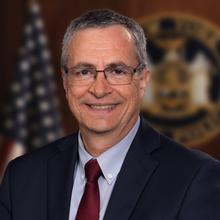
It is my honor and privilege to serve as the Forensic Science Standards Board (FSSB) Chair for 2021-2022. My current role on the FSSB is as the American Society of Crime Laboratory Directors (ASCLD) representative, a position that I have been in since 2017. I have large shoes to fill as the 4th FSSB Chair, working with Board members to support and provide strategic direction to over 800 OSAC members and affiliates. Our OSAC effort is a noble one, providing expertise for standards development to support Sound Science Serving Justice. Thank you for your ongoing efforts and dedication to our cause!
We are ably assisted by a dynamic OSAC Program Office (OPO), who provide full time support to anchor our work. They are open and available at every turn to reinforce our efforts and are great at their job. Thank you!
With the advent of the new term, a key goal of our FSSB is to be more strategic in our vision. Standards development and maintenance is an ongoing effort, with each standard coming up for review and renewal every five years, at minimum. Knowing our work is never done, each new draft standard represents a step forward built from consensus; a snapshot in time which will serve as a foundation for an even better version next time out. When OSAC first began seven years ago, we strove to accomplish two things: 1) generate the seed documents to be further developed in formal standards developing organizations (SDOs) and 2) populate the OSAC Registry. As we progress, our focus is shifting to the implementation of standards now on the OSAC Registry.
The FSSB believes that the OSAC can provide additional guidance and tools that will assist forensic service providers in putting these standards into action.
At the writing of this message, we now have 77 standards on the OSAC Registry, with many, many more in the process. This process itself has been much like building a plane while flying it. We are learning from our experiences and making improvements on the fly! With that, we appreciate the community’s flexibility and willingness to try new approaches to improve our pathway forward. The goal of each change is to increase our consistency, openness, and transparency, while attempting to streamline and consolidate our processes.
I am very excited to work with our members, affiliates and the FSSB over the next year to bring your great ideas to life, to see them implemented, and continue to improve our forensic products and services. Please feel free to share any ideas, comments, concerns, and suggestions at any time. Through our diversity and inclusion of a wide variety of backgrounds and opinions, we and our endeavor grow stronger.
Best regards,
Ray Wickenheiser, FSSB Chair
OSAC 2021 Registry Implementation Survey: Preliminary Results
Background
OSAC wants to better understand how the standards on the OSAC Registry are being used, the challenges around standards implementation, and what support is needed to improve it. To collect this information, OSAC launched and will be distributing a Registry Implementation Survey on an annual basis.
The first survey, which was open from June 10, 2021 through August 31, 2021, provided a snapshot and assessment of 46 standards that were posted on the OSAC Registry through March 2021. The survey targeted forensic science service providers from across the United States, and participants were asked to submit one response per organization and location.
This newsletter provides a preliminary report of the results from the first OSAC Registry Implementation Survey. A detailed report, focusing on 14 disciplines and 46 standards represented in the survey, will be released in early 2022.
Respondent Demographics
Organization Type. There were 155 responses to the OSAC Registry Implementation Survey [1]. Most respondents were from U.S. State Government organizations (47.1%) with the U.S. county (18.7%) organization type being the second most common. Other U.S. organization types represented included city government (15.5%), private (12.9%), federal (5.2%), and academic (0.6%) organizations (Figure A).
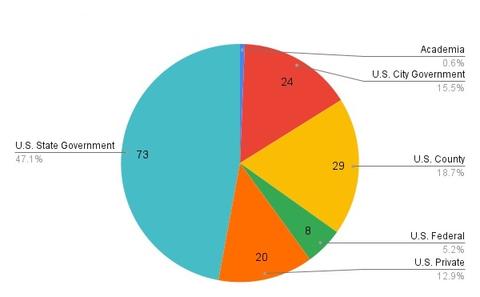
Geographic Region. The 155 survey respondents represented 38 states in the U.S. The South region of the U.S., which includes the South Atlantic, East South Central and West South Central divisions, was most heavily represented in the survey (37%). The West region, consisting of the Mountain and Pacific divisions, was the second most common region represented (26%) [2]. See Table A for the Organization Region Chart and Figure B for the Organization Region Heat Map.
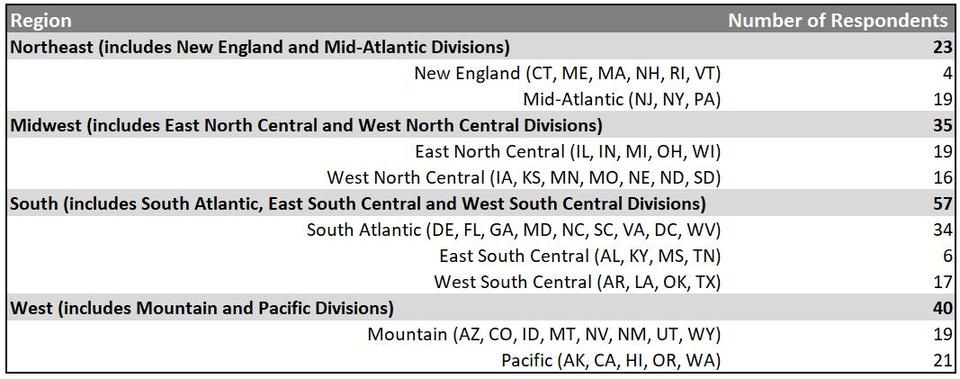
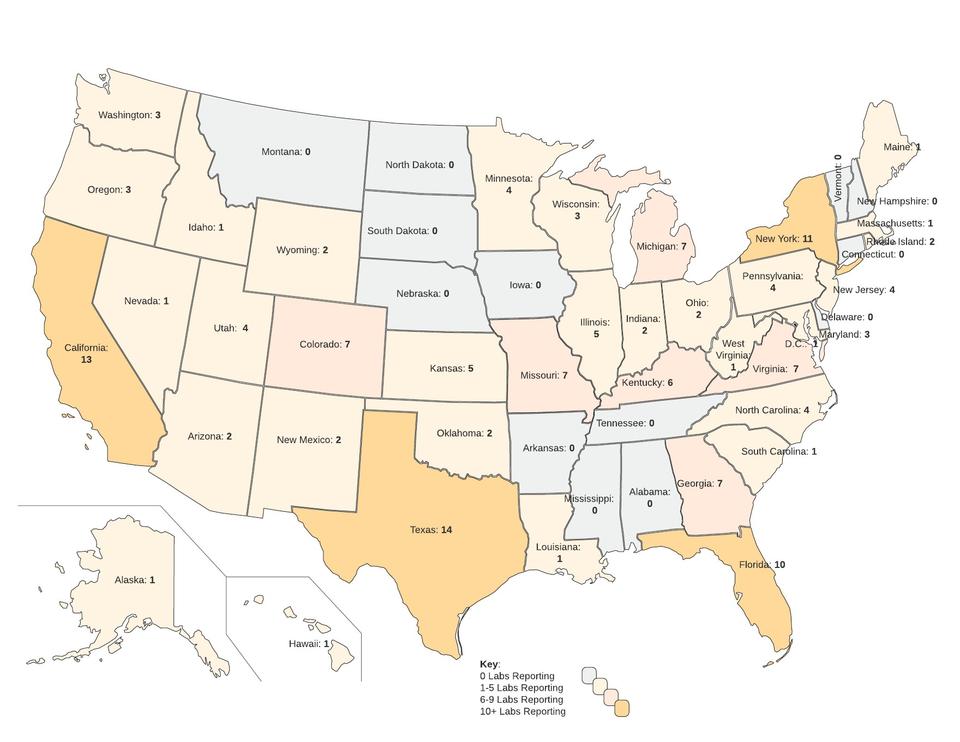
Respondent Roles. Of the 155 respondents, more than 75% were in upper management positions with 40.6% working as quality managers, followed by 37.4% working in a director or deputy role. Other positions represented included managers/section leaders (11%), practitioners/examiners (9.7%), and organization owners (1.3%) (Figure C).
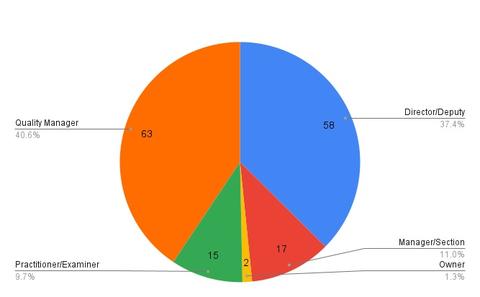
OSAC Registry Awareness. Participants were asked if individuals in their organizations were aware of the OSAC Registry. Most respondents (98%) acknowledged that individuals in their organization were knowledgeable of the standards on the OSAC Registry.
Priority for Implementing Standards. When asked what priority did survey participants consider standards implementation for their organization, half of the respondents (50%) said it was a medium priority, or important. This was followed by 34% of respondents indicating that implementation was a high priority, or very important. Twenty-three respondents (14.8%) indicated that implementation was a low priority or not a priority at this time (Figure D).
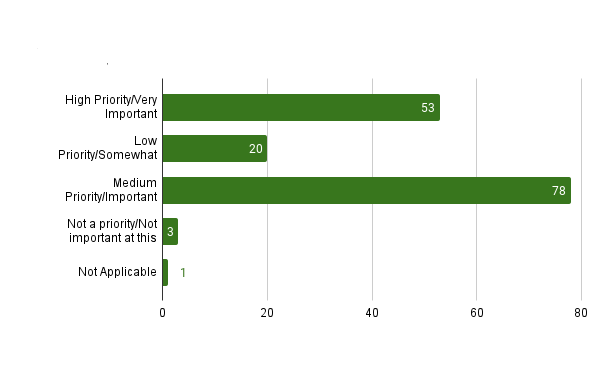
Key Challenges to Implementation. While 98% of survey respondents indicated that individuals in their organization were aware of the standards on the Registry, OSAC wanted to learn more about some of the challenges these forensic science service providers faced when implementing them. Survey participants were asked to select up to five key challenges from a list of 14 options. Of the responses, 71 indicated there were no major challenges and their organization supports implementation polices. See Table B for the key challenges identified from the 388 responses.
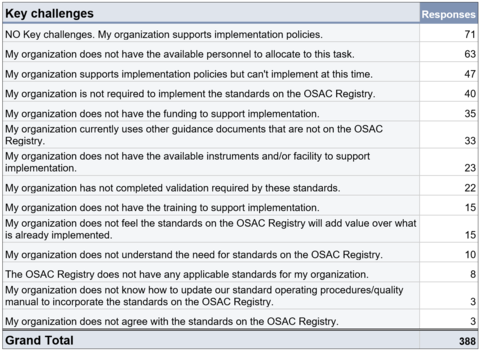
Organizations Participating in Full and Partial Standards Implementation. This survey included 46 standards that were posted on the OSAC Registry through March 2021. Of these, 44 standards have been implemented, either fully or partially.
The standard that has been implemented the most by respondents is ISO/IEC 17025:2017 General requirements for the Competence of Testing and Calibration Laboratories. This standard specifies the general requirements for the competence, impartiality, and consistent operation of laboratories and is a key standard used to accredit forensic laboratories. The survey results support this as 73% of the respondents noted that they have implemented ISO 17025:2017, either fully or partially, at their organization.
Following ISO/IEC 17025, two seized drug standards, ASTM E2329-17 Standard Practice for Identification of Seized Drugs (55%), and ASTM E2548-11e Standard Guide for Sampling Seized Drugs for Qualitative and Quantitative Analysis (52%) were implemented most. See Figure E for the number of respondents that have indicated full or partial implementation of the 46 standards in this survey.
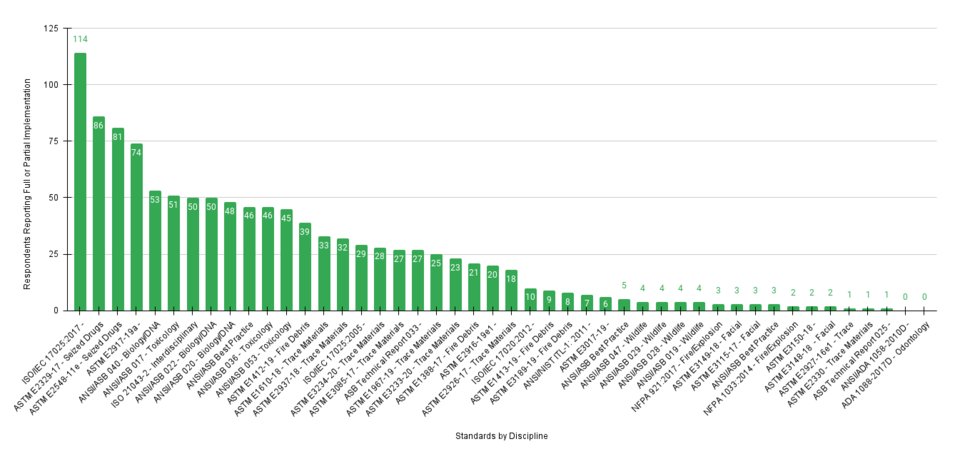
Of the 155 respondents, 17 indicated that they have not implemented, either fully or partially, any of the standards on the OSAC Registry. The remaining 138 respondents have either partially or fully implemented at least one standard on the OSAC Registry other than ISO/IEC 17025:2017.
Key Takeaways from Initial Survey Data
- Survey responses represent forensic science service providers from 38 states and across a range of organization types, roles, and geographical regions.
- Most survey respondents (98%) are aware of the standards on the OSAC Registry.
- Most survey respondents (85%) consider implementation a priority.
- Survey responses identified the top key challenges to implementation as not having personnel to allocate to the task and organizations not being able or required to implement the standards on the OSAC Registry at this time.
- Over 100 forensic science service providers are using the standards on the OSAC Registry. Of the 46 standards included in this survey, 44 are being implemented.
- Survey responses represent broad and deep implementation efforts.
[1] 27 responses were removed because they were not from a forensic science service provider.
[2] Regions and divisions taken from U.S. Census Bureau: https://www2.census.gov/geo/pdfs/maps-data/maps/reference/us_regdiv.pdf
OSAC News
Trace Evidence Collection App Now Available!
The Trace Evidence Collection Guide is a mobile app that can be used to help identify, collect, and package trace evidence at crime scenes. NIST and members of OSAC approached the Forensic Technology Center of Excellence (FTCoE) with the idea of adapting the content from OSAC’s Trace Materials Crime Scene Investigation Guide, so the application could be easily accessible and used by crime scene investigators in the field.
For more information and links to download the app, visit the OSAC website.

OSAC Welcomes Chair and Members of Forensic Nursing Subcommittee

On September 27, 2021 the FSSB selected Dr. Joyce Williams to be the chair of OSAC’s Forensic Nursing Subcommittee.
Dr. Williams currently serves as a consultant for Forensic Healthcare Consulting, LLC, is chair of the Forensic Nursing Science Section of the American Academy of Forensic Sciences and has demonstrated significant leadership in the forensic nursing field.
In October, OSAC’s Medicine Scientific Area Committee (SAC), which the Forensic Nursing Subcommittee is part of, selected the initial members of the Forensic Nursing Subcommittee. Dr. Williams, along with employees of the DOJ Office on Violence Against Women (OVW), also participated in the subcommittee membership selection process.
The Forensic Nursing Subcommittee will initially draft standards related to the collection and storage of physical evidence from victims of sexual assault, sexual assault examinations, development and validation of new methods, and training and continuing education of practitioners.
OSAC FSSB Member Appointments for FY 2022
The FSSB approved the following FSSB Executive Task Group and new FSSB members for fiscal year (FY) 2022. These individuals began their roles on October 1, 2021:
FSSB Executive Task Group Members:



New FSSB Members:
- Sarah Kerrigan, Society of Forensic Toxicologists (SOFT) representative.
- Lora Sims, Digital/Multimedia SAC Chair.
- Carl Sobieralski, Biology SAC Chair.
To see all the current members of OSAC’s FSSB, visit the FSSB webpage on the OSAC website.
2021 OSAC Leadership Strategy Session Highlights

On August 31, OSAC leaders came together (virtually!) at the OSAC Leadership Strategy Session (OLSS) to look back and share their accomplishments and challenges from fiscal year (FY) 2021.
As the FSSB works to finalize OSAC’s revised organizational priorities and long-term strategic plan, OSAC units will have a chance to establish new goals in the coming months to better align with these initiatives. The following individuals were recognized at the OLSS for their leadership and efforts to further the OSAC mission and objectives:
- Laurel Farrell for her service as chair and member of the FSSB.
- Lesley Hammer for her service as vice chair of the Physics/Pattern Interpretation SAC.
- Gerry LaPorte for his service as chair of the Forensic Document Examination Subcommittee.
- Lam Nguyen for his service as vice chair of the Digital/Multimedia SAC and chair of the Digital Evidence Subcommittee.
- Robyn Ragsdale for her service as a member of the FSSB and chair of the Biology SAC.
- Lora Sims for her service as chair of the Facial Identification Subcommittee.
- William Thompson for his service as a member of the FSSB and chair of the Human Factors Task Group.
- Richard Vorder Bruegge for his service as a member of the FSSB and chair of the Digital/Multimedia SAC.
2021 OSAC Awards

Also, at the OLSS, OSAC recognized the following individuals and group for their outstanding and extraordinary efforts in supporting OSAC’s mission.
Individual Contributor Award
- Beth Ordeman, Chair of OSAC’s Human Forensic Biology Subcommittee.
- Kim Kunkler, Member of OSAC’s Ignitable Liquids, Explosives, & Gunshot Residue Subcommittee.
- Richard Vorder Bruegge, former Chair of OSAC’s Digital/Multimedia SAC.
Outstanding Group Award
- OSAC’s Ignitable Liquids, Explosives, & Gunshot Residue Subcommittee
Sharon B. Nakich Award
- Celeste Grover, Vice Chair of the Trace Materials Subcommittee, received this award in recognition of her helpful attitude, kindness, and teamwork to support the goals of OSAC.
OSAC Registry Updates
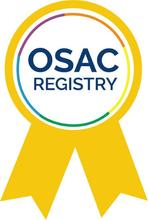
Registry Additions: FY 2021 Q4
The OSAC Registry is a repository of high-quality, technically sound published and proposed standards for forensic science. These written documents define minimum requirements, best practices, standard protocols and other guidance to ensure that the results of forensic analysis are valid, reliable and reproducible.
OSAC added 17 standards to the Registry in FY 2021 Q4 (July 1 – September 30). These included the following 13 SDO published standards, along with four OSAC Proposed Standards:
SDO Published Standards:
- ASTM E1968-19 Standard Practice for Microcrystal Testing in Forensic Analysis for Cocaine (added July 6, 2021).
- ASTM E1969-19 Standard Practice for Microcrystal Testing in the Forensic Analysis of Methamphetamine and Amphetamine (added July 6, 2021).
- ASTM E2125-19 Standard Practice for Microcrystal Testing in the Forensic Analysis of Phencyclidine and its Analogues (added July 6, 2021).
- ASTM E2882-19 Standard Guide for Analysis of Clandestine Drug Laboratory Evidence (added July 6, 2021).
- ANSI/ASB Standard 023, Standard for Training in Forensic DNA Isolation and Purification Methods, First Edition, 2020 (added August 3, 2021).
- ANSI/ASB Standard 110, Standards for Training in Forensic Serological Methods, First Edition, 2020 (added August 3, 2021).
- ANSI/ASB Standard 115, Standard for Training in Forensic Short Tandem Repeat Typing Methods using Amplification, DNA Separation, and Allele Detection, First Edition, 2020 (added August 3, 2021).
- ANSI/ASB Standard 116, Standard for Training in Forensic DNA Quantification Methods, First Edition, 2020 (added August 3, 2021).
- ANSI/ASB Best Practice Recommendation 009, Best Practice Recommendations for the Examination of Human Remains by Forensic Pathologists in the Disaster Victim Identification Context, First Edition, 2019 (added September 7, 2021).
- ANSI/ASB Best Practice Recommendation 049, Best Practice Recommendation for Lifting of Footwear and Tire Impressions, First Edition, 2020 (added September 7, 2021).
- ANSI/ASB Best Practice Recommendation 089, Best Practice Recommendation for Facial Approximation in Forensic Anthropology, First Edition, 2020 (added September 7, 2021).
- ASTM E1588-20 Standard Practice for Gunshot Residue Analysis by Scanning Electron Microscopy/Energy Dispersive X-Ray Spectrometry (added September 7, 2021).
- ASTM E3272-21 Standard Guide for the Collection of Soils and Other Geological Evidence for Criminal Forensic Applications (added September 7, 2021).
OSAC Proposed Standards
- OSAC 2021-N-0007, Media Communications Following a Mass Fatality Incident: Best Practice Recommendations for the Medicolegal Authority (added August 3, 2021).
- OSAC 2021-N-0008, Victim Accounting: Best Practice Recommendations for Medicolegal Authorities in Mass Fatality Management (added August 3, 2021).
- OSAC 2021-N-0015, Best Practice Recommendation for Guiding Principles for Scene Investigation and Reconstruction (added September 7, 2021).
- OSAC 2021-N-0016, Standard for Initial Responses at Scenes by Law Enforcement (added September 7, 2021).
To access all the standards currently on the OSAC Registry, visit the OSAC website. OSAC encourages the forensic science community to implement these SDO published and OSAC Proposed Standards into their everyday practice.
OSAC Registry Implementation Corner
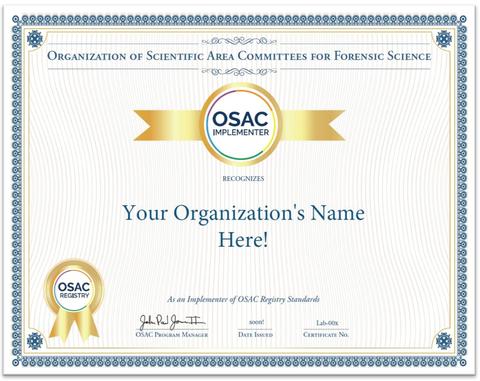
At the end of FY 2021, OSAC had awarded 47 certificates to forensic science service providers that self-declared their adoption, either fully or partially, of the standards on the OSAC Registry.
Here’s a look at media releases highlighting the efforts of some recent OSAC Registry implementers.
ISPFS Continues and Expands Accreditation, Certification, and OSAC Participation
On September 9, 2021, Idaho State Police Forensic Services (ISPFS) announced that its three laboratories comply, or are in the process of complying, with all applicable standards on the OSAC Registry. Read more about ISPFS’s recent accreditation, certification, and implementation efforts on the ISPFS website.
Michigan State Police Forensic Labs Adopt Rigorous National Standards
The Michigan State Police issued a news release on September 23, 2021 recognizing seven laboratories of the Michigan State Police Forensic Science Division (MSP-FSD) for their efforts in implementing standards on the OSAC Registry. This announcement was also reshared by two local news outlets, The Benzie County Record Patriot and 9&10 News.
BSO’s Crime Lab Recognized for National Forensic Science Standards
The Broward Sheriff’s Office Crime Laboratory was recognized as an implementer of the standards on the OSAC Registry in this news release issued October 19, 2021.
DPS Labs Adopt New National Science Standards
The Texas Department of Public Safety (DPS) issued a news release on November 5, 2021 announcing the 14 laboratories in its Crime Laboratory Division have been recognized as implementers of the standards on the OSAC Registry. This announcement was also reshared on the local news outlet, MyParisTexas.
OSAC: A Year in Review
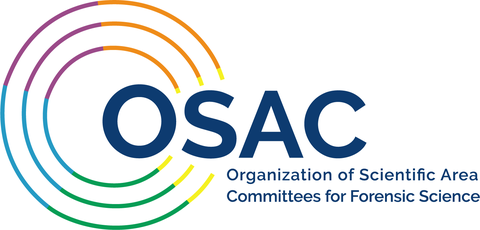
In addition to delivering quarterly updates, the fall edition of the OSAC Newsletter also serves as OSAC’s annual report and provides a review of OSAC’s accomplishments and activities over the past fiscal year, October 1, 2020 through September 30, 2021.
Organizational Snapshot
In February 2021, OSAC entered its seventh year of existence and at the end of FY 2021 had:
• 459 members
• 354 active affiliates
• 1,100+ member and affiliate applications
The employer and job classifications of OSAC members include:
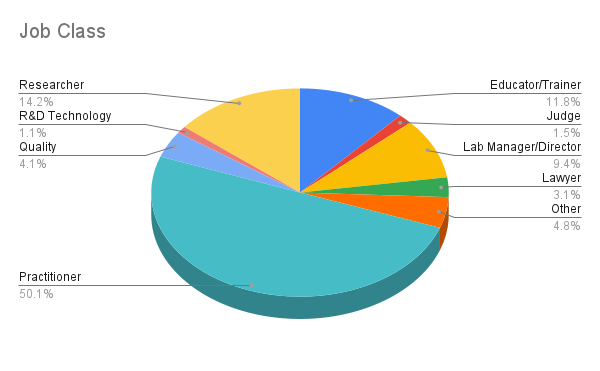
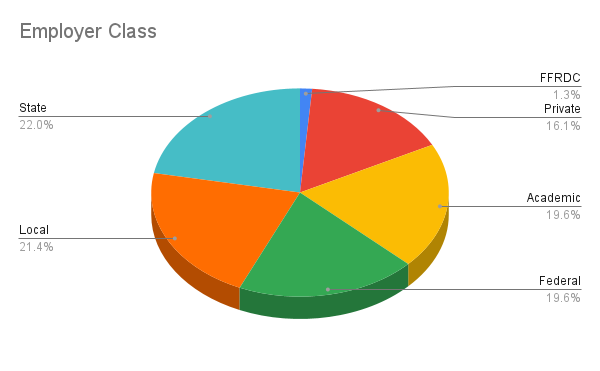
Changes to OSAC's Structure and Processes: One Year Later
October 1, 2021 marked one full year since NIST launched the new and streamlined OSAC. The changes to OSAC’s structure and processes were implemented to make high-quality, science-based standards available to the forensic community more quickly.
Changes to OSAC’s structure included:
- Adding a new scientific area committee (SAC) for forensic medicine, which included a new Forensic Nursing Subcommittee.
- Separating the chemistry SAC into two SACs, each focused on a different aspect of forensic chemistry.
- Combining closely related subcommittees, reducing their number from 25 to 22, to improve internal coordination and reduce duplication of effort.
- Allowing for the formation of interdisciplinary committees to address topics that span multiple traditional forensic disciplines.
Changes to OSAC’s processes included:
- Establishing independent Scientific & Technical Review Panels (STRPs) to evaluate draft OSAC Proposed Standards before they are sent to an SDO.
- Inviting public comments earlier in the drafting stage to help ensure that proposed standards meet OSAC’s high bar for quality before being forwarded to an SDO.
- Including OSAC Proposed Standards on the Registry alongside published standards to help fill the standards gaps during the time it takes for an SDO to complete the development and publication process. This will also allow labs to get a head start on implementing high-quality standards.
During the past year, these upgrades have resulted in the first 19 members being added to the Forensic Nursing Subcommittee and 24 OSAC Proposed Standards (8 STRP & 16 non-STRP) being evaluated through our more streamlined review process, which includes public comment. By the end of the fiscal year, eight of those OSAC Proposed Standards were added to the OSAC Registry. Embracing the spirit of continuous improvement, OSAC recognizes that additional adjustments may be needed to further streamline some of these processes.
OSAC Registry

The OSAC Registry reached a milestone this past April as the 50th standard was added to it! Read more about the beginnings of the Registry and its growth in this OSAC news article.
A total of 35 new forensic science standards were added to the OSAC Registry this fiscal year, representing a 94% increase in growth. At the end of FY 2021, the OSAC Registry contained 72 standards (64 published and 8 OSAC Proposed), representing over 15 specific forensic science disciplines and various interdisciplinary topics.
The chart below shows the number of standards that were on the OSAC Registry (in bold) at the end of the past six fiscal years.
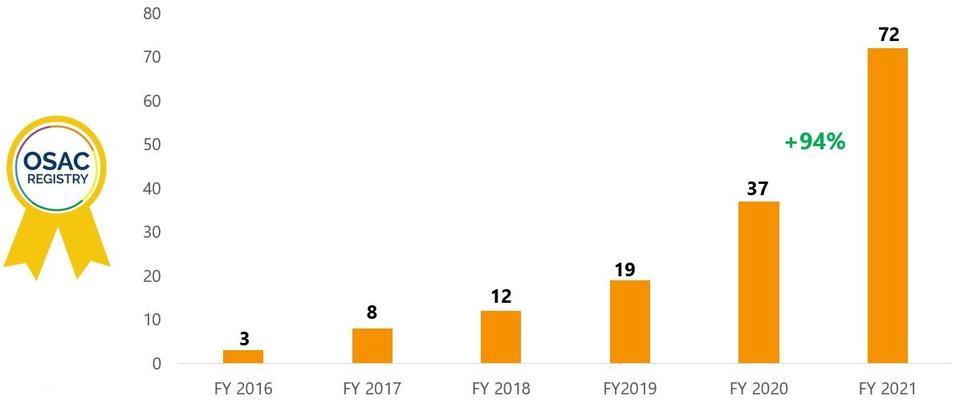
To see a current list of standards on the OSAC Registry and a breakdown of standards by fiscal year, visit the OSAC Registry webpage.
Registry Implementation Efforts
OSAC continued to focus its implementation efforts on crime laboratories and other forensic science service providers (FSSPs) this past fiscal year.
During FY 2021, OSAC received 47 Standards Implementation Declaration forms from forensic science organizations across the county and internationally. These declarations were from:
- 33 state lab locations (representing six states)
- 9 local/county/city laboratories
- 2 private laboratories
- 1 university laboratory
- 2 international laboratories
In addition to forensic science service providers, seven professional organizations also formally declared their support of OSAC and the development and implementation of forensic science standards. Read the policy and position statements from these organizations, all represented on OSAC’s FSSB, on OSAC’s Registry Implementation webpage.
OSAC Registry implementation efforts this year focused on forensic science service providers. Moving forward, we will expand our focus to include professional forensic science organizations, prosecutors, defense attorneys, and the courts. We encourage forensic science service providers to initiate the standards implementation process in their operations proactively, so they will be prepared to share the value of standardization when addressing these topics in court.
Ongoing Standards Activities
At the end of FY 2021 there were 72 standards on the OSAC Registry. In addition, there were:
- More than 50 SDO-published standards eligible for OSAC review for placement on the OSAC Registry.
- Over 130 OSAC-drafted standards progressing through the development process at SDOs.
- More than 160 documents being drafted within OSAC.
Below is a snapshot of the number of documents each subcommittee had at each stage in the OSAC development process at the end of FY 2021:
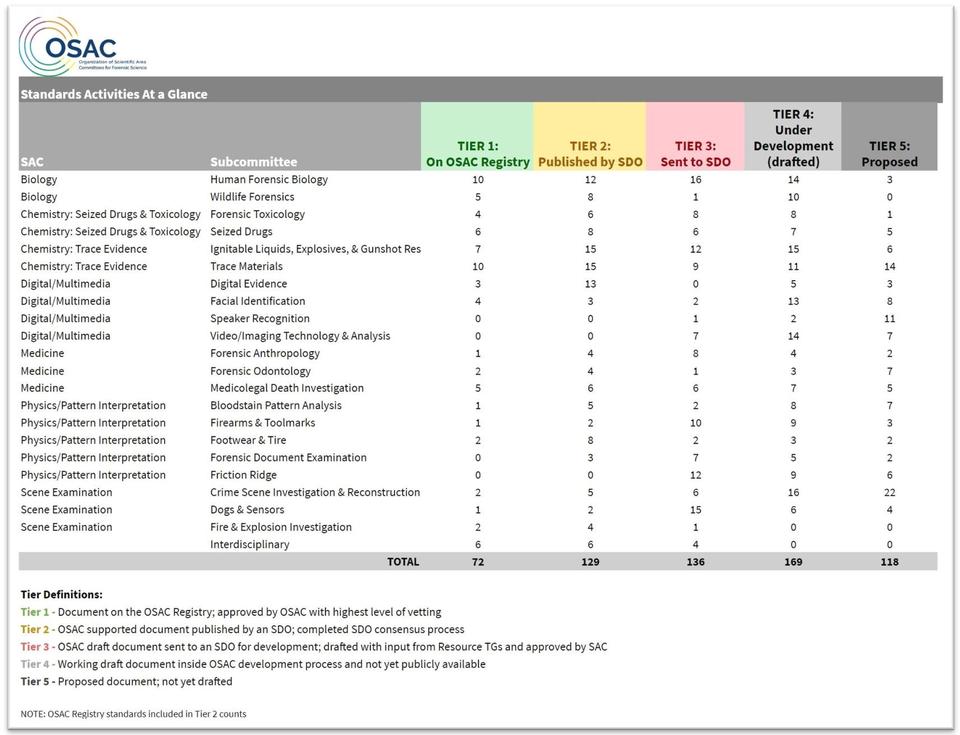
Other Accomplishments
In addition to growing the Registry and facilitating standards activities, here are some other work products and accomplishments from the last year:
- OSAC, in partnership with NIST’s Forensic Science Research Program and the Association of Firearm and Tool Mark Examiners (AFTE), published a firearms process map on January 19, 2021. OSAC has also supported the development of process maps for the DNA, fire investigation, footwear, and seized drugs disciplines and expect these to be published in 2022. Process maps are a useful tool that can help forensic science disciplines provide insight into their specific activities, identify areas for improvement and discover where standards may be needed.
- Members of OSAC’s Human Forensic Biology Subcommittee, along with the AAFS Standards Board (ASB) and Promega, presented a webinar in January 2021 on the standard for validation of probabilistic genotyping. This webinar is part of a four-part series that provides information on new/emerging standards and best practices for forensic biology and DNA testing laboratories.
- In April 2021, members of OSAC’s Fire & Explosion Investigation Subcommittee published an OSAC Technical Guidance Document, Strengthening Fire and Explosion Investigation in the United States: A Strategic Vision for Moving Forward, which recommends a strategic plan for improvements in fire and explosion investigation as a forensic science discipline.
- Also in April, members of OSAC’s Speaker Recognition Subcommittee published a bibliographic reference document, Essential Scientific Literature for Human-Supervised Automatic Approaches to Forensic Speaker Recognition.
- OSAC launched its first Registry Implementation Survey in June 2021. This will be an annual survey to better understand how the standards on the OSAC Registry are being used, the challenges around standards implementation, and what support is needed to improve it.
- OSAC further refined its Organizational Priorities and Minimum Topic Requirements for Standards Development document to better identify and clarify the minimum topic requirements that subcommittees should address when drafting forensic science standards and published a revised version in September 2021.
- OSAC subcommittees reviewed and updated 101 research and development needs this year. Academic institutions, federal agencies, and other research organizations can access the 147 research and development needs on the OSAC website to help address technical challenges identified by forensic science service providers.
- OSAC continued to develop and improve the OSAC Lexicon. OSAC’s Terminology and Preferred Terms Task Groups focused their efforts this year on reviewing, refining, and removing duplicate terms in the OSAC Lexicon. The FSSB approved the addition of four new OSAC-preferred terms to the Lexicon in FY 2021: peer review, repeatability, replicability, and reproducibility. At the end of FY 2021, there were 26 OSAC-preferred terms that OSAC members are encouraged to use when drafting standards.
- Despite not being able to travel and meet in-person this year, OSAC units and the FSSB remained productive and engaged. The OSAC Program Office moved to an all-virtual meeting platform and supported 11 committee meetings (averaging three to five days each), bimonthly FSSB teleconferences, quarterly FSSB in-depth meetings, the annual OSAC Leadership Strategy Session, and OSAC Public Update Meeting. You can view the recording of the Public Update Meeting here.
- OSAC has continuously improved our internal operations to increase collaboration among OSAC units and manage our documents more effectively.
- In recognition and celebration of this year’s National Forensic Science Week, September 19-25, 2021, OSAC took to LinkedIn and highlighted several standards and other standards-supporting topics that will have an impact on the forensic science community. You can see the compilation of our posts here.
- OSAC continued to grow our digital presence, as evidenced by an increase in website views, downloads, and LinkedIn posts and followers. As our outreach grows, so does our ability to reach more stakeholders and educate the forensic science community about new standards being developed and championed by OSAC.
Engagement Activities
Stakeholder Outreach Meetings

To formalize engagement with key stakeholder groups that support our mission and to provide an opportunity for dialog between these stakeholders and OSAC leadership, OSAC held two stakeholder outreach meetings this fiscal year.
The first meeting, held January 27, was with standards developing organizations (SDOs), proficiency testing providers, accreditation bodies, and certification bodies. Through a series of facilitated discussions, over 60 attendees provided ideas, shared challenges, and identified opportunities for improvement related to the development and implementation of forensic science standards.
The second stakeholder outreach meeting was held on May 27 with forensic laboratory leaders and other key decision-makers providing forensic services. Twenty-eight forensic laboratory leaders, representing federal, state, local, and private organizations discussed the current challenges and opportunities for improvement related to forensic science testing, quality management, and standards.
A third stakeholder outreach meeting is planned for January 20, 2022 with Professional Society Organizations.
The feedback OSAC received from both stakeholder groups was extremely valuable and is being used to help inform our future plans and priorities. You can view a summary report and key takeaways from each of these meetings on the OSAC Events page.
OSAC Public Update Meeting
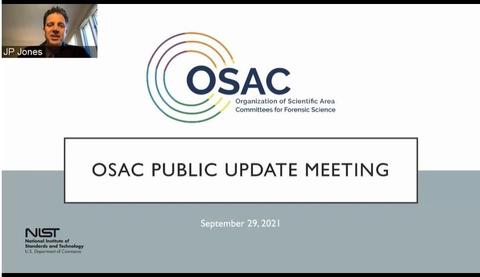
OSAC is committed to sharing information about standards and activities that will impact the forensic science community.
Each year, OSAC reports its activities in an open and online public forum and provides an opportunity for the public to ask questions and provide feedback. Over 450 people, including 33 international attendees, tuned in to this year’s Public Update Meeting on September 29. During this virtual event, the chairs of OSAC’s seven SACs and the FSSB described their unit’s activities, including the standards they are working on, challenges being addressed, and priorities for the upcoming year.
If you were unable to attend this year’s meeting, on-demand viewing of the recorded meeting is available on the OSAC Events page and individual presentation slides are available on individual SAC webpages.
Other Outreach Events
Despite the inability to meet in person, OSAC members, affiliates, and OSAC Program Office staff gave 42 OSAC-related presentations at various forensic science conferences and meetings this fiscal year, some of which included:
- AFQAM Annual Training Conference, October 2020.
- ASTM Workshop on Interlaboratory Studies and Collaborative Research in the Forensic Sciences, October 2020.
- California Association of Crime Laboratory Directors Meeting, November 2020.
- Midwest Firearms Examiner Training Session, November 2020.
- NY Crime Laboratory Advisory Committee Meeting, December 2020.
- AAFS Annual Scientific Meeting, February 2021. There were plenty of standards-related presentations and OSAC participation at the first AAFS virtual meeting. Read the highlights here.
- Association for Crime Scene Reconstruction Conference, March 2021.
- Bode Conference, May 2021.
- Florida International University (FIU) Symposium, June 2021.
- International Association of Coroners and Medical Examiners (IACME) Training Symposium, July 2021.
- International Association for Identification (IAI) Annual Conference, August 2021.
- Association of Firearm and Tool Mark Examiners Annual Training Seminar, August 2021.
- South Carolina Division of the IAI Education Conference, August 2021.
Along with giving presentations, OSAC was able to share information and engage with the forensic science community through these other activities:
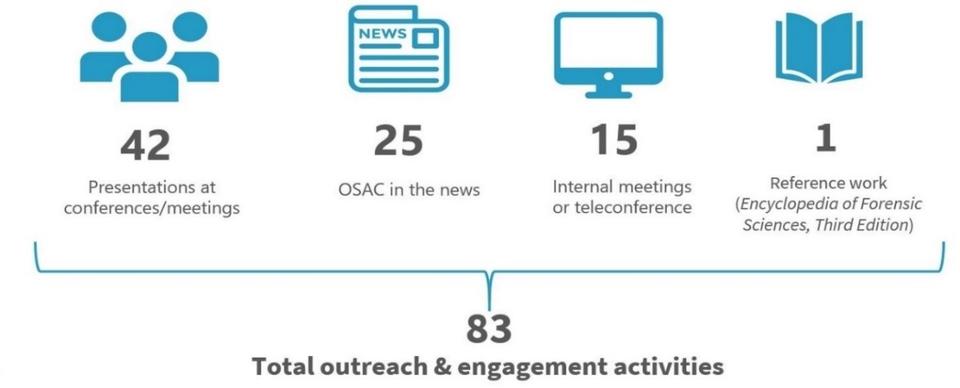
OSAC in the News
Special Technical Committee on Color Test Reagents/Kits for Preliminary Identification of Drugs of Abuse
This notice in the Federal Register announced NIJ’s intention to use OSAC’s Seized Drugs Subcommittee members and affiliates as the Special Technical Committee for the revision of the NIJ Color Test Standard.
An Update from the Organization of Scientific Area Committees for Forensic Science
The September 2021 issue of the ISHI Report shared updates from OSAC’s Human Forensic Biology Subcommittee.
National Forensic Science Week 2021: An Expert’s Advocacy Guide
OSAC member Judge Stephanie Domitrovich talks about the importance of standards and education in the forensic sciences in this Forensic Colleges blog.
OSAC & Other Forensic Science Events
2022
February 21-25: 2022 AAFS Annual Scientific Meeting, Seattle, WA. There will be plenty of OSAC participation, standard-related presentations, and a NIST exhibit booth featuring OSAC at this year’s AAFS meeting!
April 24-28: 2022 ASCLD Symposium, Reno, NV. OSAC will be an exhibitor at this year’s ASCLD Symposium – be sure to visit us!
May 16-20: OSAC Meetings for Scene Examination SAC & subcommittees and Physics/Pattern SAC & subcommittees, Orlando, FL.
May 23-27: OSAC Meetings for Medicine SAC & subcommittees and Digital/Multimedia SAC & subcommittees, Orlando, FL
June (dates to be determined): OSAC Meetings for Biology SAC & subcommittees, Chemistry: Seized Drugs & Toxicology SAC & subcommittees, and Chemistry: Trace Evidence SAC & subcommittees, Orlando, FL.
NIST Research Activities
The NIST Forensic Science Team is developing a searchable catalog of forensically relevant software and algorithms as a task in a planned program in Computational Forensic Science.
Computational forensic science is built on algorithms and the software systems that execute those algorithms. Creating this catalog is an important first step in guiding future research in this important topic area and will provide a deeper understanding of the state of practice in algorithmic forensic science.
We are asking you to help us identify any known forensic software or algorithm currently in use of which you may be aware, to assist with the collection of needed data to populate this new database. The team is looking primarily for the name of the software and a URL, but any supplemental information that you can provide would be greatly appreciated (but not required). Those who wish to submit multiple entries may do so in plain text email or an excel spreadsheet.
Submissions may be sent to Corrine Lloyd (corrine.lloyd [at] nist.gov (Corrine[dot]Lloyd[at]nist[dot]gov)) along with any questions.
A beta version of the developing catalog can be viewed at https://forensicsoftware.nist.gov. The team intends to have a public-facing catalog available in 2022.

